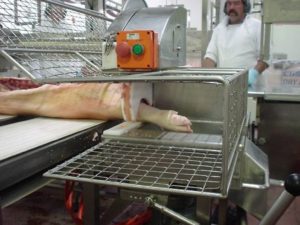Step one: Identify the hazards
Hazards may be identified by measures including:
- direct observation
- consultation with workers
- analysis of historical data
- risk control program of manual tasks
Direct observation
Direct observation of a task or process may be completed using a checklist or other survey tool. Observation should occur while the usual work is being performed. It may identify risks overlooked in the daily routines.
Consultation with employees and their representatives
Employees should participate in all stages of identifying, assessing and controlling the risks associated with manual handling. Employees are likely to be aware of the risks associated with their work and are often able to put forward practical suggestions.
Analysis of historical data
This includes injury records, but also accident reports, previous audits, surveys, inspection by occupational health and safety staff, WHS committees or outside consultants. Meat industry experience may indicate trends to be considered.
Risk control program of manual tasks
A risk control program of manual tasks should be undertaken by senior management of all manual handling tasks.
Step two: Assessing the risks
Assessment of risk is undertaken to identify the specific factors that may pose a risk of injury. Generally a number of factors combine to increase the risk. One way to take a systematic approach to the identification of risk factors is to consider.
The task factors – what is being done:
- working posture, actions and movements
- duration and frequency of the activity
- location of the loads and the distance it is moved
- characteristic of the load and equipment
- weight and forces.
Work environment factors – where the task is performed:
- layout of the workplace
- condition of the workplace.
Work organisation factors – how the task is organised:
- work flow
- work loads
- work breaks.
Worker factors – who is doing the task:
- skills and experience of the worker
- specific clothing and other personal protective equipment (PPE)
- age and fitness level.
Step three: Controlling the risks
Once management have identified the hazardous manual tasks and assessed the factors that make them hazardous, then they are in a position to be able to identify the most effective control measures to eliminate the risks where possible or if that is not possible to reduce the risks to the lowest possible levels.
Purchasing to eliminate or minimise risks
Companies generally have a purchasing policy that focuses on purchasing plant and equipment has been designed so that it can be used safely and best matches the needs of your workers. For example a robot may eliminate a hazardous manual task.

Automated hock cutter
© QAF Meats
